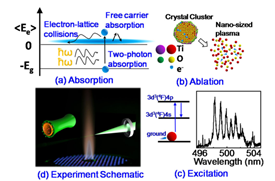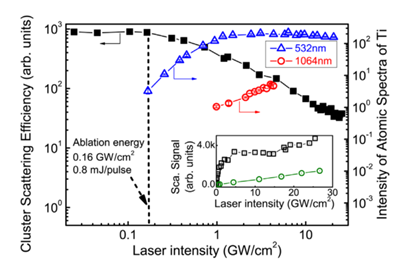Absorption-ablation-excitation mechanism of laser-cluster interactions in a nanoaerosol system
The absorption-ablation-excitation mechanism in laser-cluster interactions is investigated by measuring Rayleigh scattering of aerosol clusters along with atomic emission from phase-selective laser-induced breakdown spectroscopy. For 532 nm excitation, as the laser intensity increases beyond 0.16 GW/cm2, the scattering cross section of TiO2 clusters begins to decrease, concurrent with the onset of atomic emission of Ti, indicating a scattering-to-ablation transition and the formation of nanoplasmas. With 1064 nm laser excitation, the atomic emissions are more than one order of magnitude weaker than that at 532 nm, indicating that the thermal effect is not the main mechanism. To better clarify the process, time-resolved measurements of scattering signals are examined for different excitation laser intensities. For increasing laser intensity, the cross-section of clusters decreases during a single pulse, evincing the shorter ablation delay time and larger ratios of ablation clusters. Assessment of the electron energy distribution during the ablation process is conducted by nondimensionalizing the Fokker-Planck equation, with analogous Strouhal SlE, Peclet PeE, and Damköhler DaE numbers defined to characterize the laser-induced aerothermochemical environment. For conditions where SlE ≫ 1, PeE ≫ 1,and DaE ≪ 1, the electrons are excited to the conduction band by two-photon absorption, then relax to the bottomof the conduction band by electron energy loss to the lattice, and finally serve as the energy transfer media between laser field and lattice. The relationship between delay time and excitation intensity is well correlated by this simplified model with quasi-steady assumption.
Publication: Ren YH, Li SQ*, Zhang YY, Tse SD, Long MB. Absorption-ablation-excitation mechanism of laser-cluster interactions in a nanoaerosol system. Physical review letters, 114(9), p.093401 (2015).


